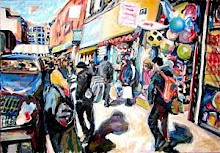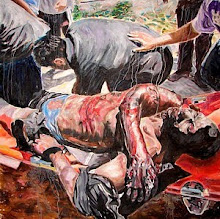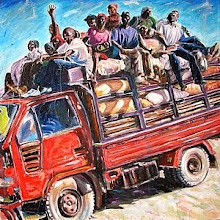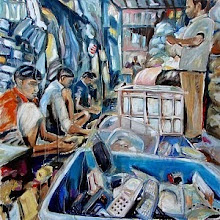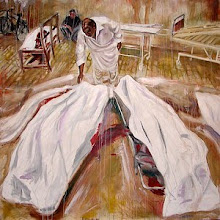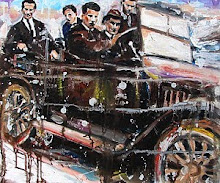Because the truth is, today's immigrants, as they have for generation after generation, work the longest hours at the hardest jobs for the lowest pay, jobs that are just about impossible to fill. Luis Gutierrez
All over the world the question of immigration is a vexing one as is it brings into sharp relief questions of nationhood and identity for the people of the countries experiencing immigration.
The Geneva-based intergovernmental body, the International Organization for Migration stated in its 4th World Migration Report that there are more than 200 million migrants around the world today. The report said that in 2005 Europe hosted the largest number of immigrants, with 70.6 million people and North American, with over 45.1 million immigrants, is second, followed by Asia, which hosts nearly 25.3 million. The report also stated that most of today's migrant workers come from Asia, and demographic data suggests that by 2030, China and India will provide 40 percent of the global work force. [1]
According to the United Nations International Migration Report 2006: A Global Assessment:
In 2004, official migrant remittances amounted to US$ 226 billion, US$ 145 billion of which went to developing countries. Remittances sent back to the home country by migrants are a major source of foreign exchange earnings for some countries and are an important addition to the gross domestic product. [2]
Immigration has often been described in terms of push and pull factors. Push factors can be to escape from poverty and the availability of jobs is a pull factor. Other push factors can be to escape oppression, persecution, dictatorship and war.
Immigrants make huge contributions to cultural, economic and political life despite the recent negative associations with terrorism, national security and unemployment. Immigrants bring variety to cultures that have been closed through tradition or narrow nationalism. The presence of immigrants also stirs up questions of national identity in the peoples of their new homeland and this in turn is reflected in culture.
In cinema, the effects of globalisation have become so strong that a developing concept of Transnational cinema has sought a redefinition or even a refutation of the concept of national cinema as production, funding and distribution increasingly supersede national borders. As communities become increasingly fragmented in terms of ethnicity, social class, gender and political belief, the influence and role of immigrants becomes more salient. In cinema, immigrant groups often initially serve as a social or political foil but which is then soon turned on its head as other aspects of immigrant culture come into play.
Immigration and cinema
In recent years three films Gangs of New York (2002), Gran Torino (2008), and The Army of Crime (French: L'Armée du crime) (2009) have looked at the issue of immigration from different perspectives that show the trials, sufferings and ultimately sacrifice of immigrants in their new homeland. In Gangs of New York many of the newly arriving Irish rapidly become canon fodder for the American Civil War or else fight it out with other immigrants for survival. In Gran Torino a conservative widower gradually comes to understand and empathise with the culture of his Hmong neighbours. In The Army of Crime a group of immigrants take up the fight against Nazi occupation in France and pay the ultimate price for their adopted country.
Gangs of New York
My whole family has been having trouble with immigrants ever since we came to this country. Edgar Y. Harburg
Gangs of New York is a 2002 American historical crime film set in the mid-19th century in the Five Points district of New York City. It was directed by Martin Scorsese and written by Jay Cocks, Steven Zaillian and Kenneth Lonergan. The film begins in 1846 and quickly jumps to the early 1860s. The two principal issues of the era in New York were Irish immigration to the city and the Federal government's execution of the Civil War. The story follows Bill "The Butcher" Cutting (Daniel Day-Lewis) in his roles as crime boss and political kingmaker under the helm of Boss Tweed (Jim Broadbent). The film culminates in a confrontation between Cutting and his mob with the protagonist Amsterdam Vallon (Leonardo DiCaprio) and his immigrant allies, which coincides with the New York Draft Riots of 1863. [3]
An extraordinary mise-en-scène shot that almost serves as a mini film within the film tells the story of the fate of many new arrivals into New York in a time of civil war in America. In one long shot the story of many Irish men was told, from their arrival in America to their tragic end in the land that they had hoped would fulfil all their hopes and dreams.

Bill (Daniel Day-Lewis) and Amsterdam (Leonardo DiCaprio) in Gangs of New York (2002) [4]
The scene starts with Bill and Amsterdam turning their backs as Bill responds, “Not our future” to the Boss Tweed who has just claimed that they were turning their backs on the future i.e. the political and economic potential of the new immigrants. The camera then pans to the left as the new Irish immigrants who have just got off one ship from Ireland are queuing up at the recruiter's harbour table where they are sworn in to the army.
Army Recruiter: That document makes you a citizen, and this one makes you a private in the Union army. Now go fight for your country.
A song is overlaid on the scene sung by a woman with the following lyrics:
Irish Singer: [singing] Well, meself and a hundred more, to America sailed o'er, with our fortunes to be made, so we were thinkin' / When we got to Yankee land, they shoved a gun into our hands / Saying "Paddy, you must go and fight for Lincoln."/ There is nothing here but war, where the murderin' cannons roar, and I wish I was back home in dear old Dublin.
The camera pans following the new recruits as they move on up to one who is changing his Irish cap for a soldier's cap. Others are getting into the uniform in assembly line fashion as another recruiter puts a gun into their hands. They then get into another line fully kitted out moving slowly towards another gangway for the ship that will take them to the war. Two soldiers can be heard conversing:
Irish Immigrant: Where we goin'?
Another Immigrant: I heard Tennessee.
Irish Immigrant: Where's that?
The camera then slowly pans along the new recruits as family members, possibly his wife and daughter, run up to one new soldier. A girl with red hair talks to another worried- looking soldier. As they start up the gangway another soldier asks:
Irish Soldier: Do they feed us now do you think?
[Earlier in the film new recruits were promised three square meals a day if they joined up].
As they move slowly up the gangway the camera cranes up higher and we can see soldiers sitting around on the ship waiting. Just then a coffin comes into view [with the number 61 stuck to it] as it is lifted with ropes by a crane in the direction of the quays. The coffin flies over the heads of the line of recruits and more coffins come into view for the first time. Soon we see two rows of 10 coffins each neatly laid out and being inspected by soldiers. Two workers carry one of the coffins past the line of new recruits [who don’t seem to notice it] and up the quay presumably to a graveyard. At this point there is a cut to a presentation of Uncle Tom’s Cabin.
This whole mise-en-scène shot lasts one minute and eight seconds.

Quay scene: Life and death. The new recruits line up on the left in Gangs of New York (2002) [5]
Historical and political ironies
Of the many ironies in this scene two stand out. In a slightly earlier scene the politician says:
Boss Tweed: That's the building of our country right there, Mr. Cutting. Americans aborning.
They may be new American citizens but the scene on the docks starts with the idea of birth and ends with death symbolised by the rows of coffins revealing the way many immigrants were seen as cannon fodder for a war they knew nothing about. Their basic desires for acceptance and food led them to a fate they were scarcely aware of.
Continuing the above dialogue, Bill, a Protestant, states his view of the Irish bluntly:
Bill: I don't see no Americans. I see trespassers, Irish harps. Do a job for a nickel what a nigger does for a dime and a white man used to get a quarter for. What have they done? Name one thing they've contributed.
Boss Tweed: Votes.
Bill: Votes, you say? They vote how the archbishop tells them, and who tells the archbishop? Their king in the pointy hat what sits on his throne in Rome.
The second irony here is that Bill sees them in religious terms and feels no solidarity or empathy for their plight as victims of British colonial policy back in Ireland despite the fact that Bill’s own father also suffered at the hands of the British:
Bill: My father gave his life, making this country what it is. Murdered by the British with all of his men on the twenty fifth of July, Anno Domini, 1814. Do you think I'm going to help you befoul his legacy, by giving this country over to them, what's had no hand in the fighting for it? Why, because they come off a boat crawling with lice and begging you for soup?
Another irony here is that the Irish immigrants were queuing up to fight and die for their new home despite not knowing very much about the issues involved and had just come off a boat ‘crawling with lice’ and begging for soup. Their lack of awareness is emphasised by the fact that they don’t seem to notice or question the array of coffins on the quay that they are walking past. They seem blissfully unaware that they have jumped from the frying pan into the fire in their relief and excitement of having finally arrived in America.
Of course, Bill was right when he said that the immigrants were not part of his future as the reign of the gangs in New York was eventually overtaken by a unified state and built up on the backs of the many immigrants who would pour in for many years to come.
Gran Torino
The more you can increase fear of drugs and crime, welfare mothers, immigrants and aliens, the more you control all the people. Noam Chomsky
Gran Torino is a 2008 American drama film directed, produced and starring Clint Eastwood. The story follows a Polish American, Walt Kowalski, a retired Ford automobile assembly line worker and recently widowed Korean War veteran who is alienated from his family and angry at the world. [6]
A Hmong family moves in next door and Walt refuses to have any dealings with them. Then Walt's young Hmong neighbor, Thao, tries to steal Walt's prized 1972 Ford Gran Torino on a dare by his cousin for initiation into a gang. Walt develops a relationship with the boy and his family. Their strong sense of community values and openness towards him has a profound affect on Walt. They insist that Thao makes reparations for his misdeed and at the same time invite Walt into their Hmong family gatherings where he is treated as one of the family. Initially embarrassed by their kindness and food offerings he begins to reflect on the values of his own family. Although he is not an easy person to get on with Walt is disappointed that his sons are far too busy to see him, his grandchildren are selfish and spoilt and, in general, they seem more interested in getting him into a retirement community.

Sue (Ahney Her) and Walt (Clint Eastwood) in Gran Torino (2008) [7]
Gradually Walt’s attitude shifts from resentment towards his poor Asian immigrant neighbours to one of empathy and support for the underdog. The gang beat up Thao for failing to rob the car and Walt steps in threatening to kill the gang if they didn’t leave Thao alone. However, the gang’s response is to attack Thao’s house in a drive-by shooting and rape his sister.
Walt realises that Thao’s family would never be safe with the gang around and devises a plan to get the gang to commit another serious crime. This time there would be plenty of witnesses and they would be put in prison for a long time but Walt sacrifices his own life in the process.

The Hmong Vang Lor family and Walt (Clint Eastwood) in Gran Torino (2008) [8]
While there are many conservative aspects to Gran Torino, the film uses an elderly protagonist and a minority community to great effect showing how racial stereotypes and negative attitudes can be overcome. It also shows how human values can transcend national identity particularly as Walt’s own family were once immigrants from Poland.
The Army of Crime (French: L'Armée du crime)
The most superficial student of Roman history must be struck by the extraordinary degree in which the fortunes of the republic were affected by the presence of foreigners, under different names, on her soil. Henry James Sumner Maine
The Army of Crime (French: L'Armée du crime) is a 2009 French drama-war film directed by Robert Guédiguian and based on a story by Serge Le Péron, one of three credited for the screenplay. It received a wide release in France on September 16, 2009 and opened in the United States in 2010.
The film deals with the events of the Affiche Rouge ("red poster") affair. The title was taken from the caption on a propaganda poster, in which the Nazis sought to present prominent resistance fighters as foreign criminals. The caption read "Liberators? Liberation by the army of crime".

Affiche Rouge ("red poster") [9]
In Paris during the German occupation, an ill-assorted group of resistance fighters commits disorganized attacks. Its membership included 22 men: eight Poles, five Italians, three Hungarians, two Armenians, a Spaniard, and three French; and one woman, who was Romanian. Eleven were also Jewish.
The film traces the story of this group, from its shaping to the execution of its members in 1944. Missak Manouchian, an Armenian exile, was ready to help but reluctant to kill; for him, being ready to die but not to kill was an ethical matter. However, circumstances led him to abandon his reluctance and under his leadership, the group structured and planned its guerrilla actions. [10]

Missak Manouchian (Simon Abkarian ) [centre] in The Army of Crime (2009) [11]
At a gathering for the group, Manouchian’s toast reminds us of his old and new identities:
Today is the anniversary of the Soviet Armenia. I remember my father killed by Turkish soldiers, my mother who died of grief and the brother I loved so much. I’m an orphan like all the other Armenian victims but I’m lucky because you’re all here, because you have become my family. A family of fighters to confront the occupier! Long live France! Long live Armenia! Long live the ILO!
However, the French police follow the group and eventually through torture find and capture the members. The film ends with the group being brought off to their execution by the Nazis.

The Manouchian group in The Army of Crime (2009) [12]
The attempt by the Nazis to portray the Manouchian group as terrorists backfired when ‘Morts pour la France’ (They died for France) was written beneath some of the Affiche Rouge posters. The complexity of national identity is revealed in the ironies of a group of foreign immigrants fighting for the freedom of France from its Nazi occupiers being captured and tortured by French police. The importance of this lesson is not lost on Arsène Tchakarian, who, at ninety-three years of age is the last living member of the Manouchian group (along with Henri Karahian). When asked, in an interview by Gérard Devienne, if the story contained in the film is important today, he replied:
One should know history so that the memory of what happened is not lost. That’s why I have already visited nearly 220 schools and given dozens of lectures, so that people might know the historical truth and can make it their own. An educational film, in the making of which I was involved, concerning the part played by emigrants in the resistance, is ready for release and will be shown in schools and colleges. [13]

Memorial to the Manouchian Group [14]
Role and influence of immigrants
As the world becomes more globalised and boundaries of national identity become more and more confused and diffused the role and influence of immigrants will also become more complex. As the above three films have shown immigrants can play many different roles, both conscious and unconscious, in the future of all our societies.
Notes:
[1] http://www.foxnews.com/wires/2008Dec02/0,4670,EUWorldMigrationReport,00.html
[2] http://www.un.org/esa/population/publications/2006_MigrationRep/exec_sum.pdf
[3] http://en.wikipedia.org/wiki/Gangs_of_New_York
[4] http://www.fanpix.net/0646236/012027172/gangs-of-new-york-2002-picture.html
[5] http://www.dvdactive.com/reviews/dvd/gangs-of-new-york4.html
[6] http://en.wikipedia.org/wiki/Gran_Torino
[7] http://betterangelsnow.com/post/135/8/gran-torino.html
[8] http://www.asiapacificforum.org/show-detail.php?show_id=139
[9] http://en.wikipedia.org/wiki/File:Affiche_rouge.jpg
[10] http://en.wikipedia.org/wiki/The_Army_of_Crime
[11] http://movies.nytimes.com/2010/08/20/movies/20army.html
[12] http://www.culch.ie/2009/10/02/army-of-crime-review/
[13] http://www.humaniteinenglish.com/spip.php?article1332
[14] http://en.wikipedia.org/wiki/Affiche_Rouge
Caoimhghin Ó Croidheáin is an Irish artist who has exhibited widely around Ireland. His work consists of drawings and paintings and features cityscapes of Dublin, images based on Irish history and other work with social/political themes (http://gaelart.net/). He is also developing a blog database of Realist and Social Realist art from around the world. These paintings can be viewed country by country on his blog at http://gaelart.blogspot.com/.



